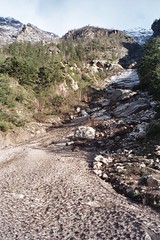
The American West has been reading the drought tea leaves for long enough. Its residents can no longer dismiss this trend as a normal cyclical fluctuation in precip. The reservoirs and water tables are not being replenished to make up for the dry years and the upper Colorado River basin pictured here is being asked to provide for more needs than it can keep up with. From now on, every year may just be a "drier than normal" year, and with millions of residents having been added to the region in recent years, it's time to get creative.
In the article An Arid West No Longer Waits for Rain (registration required), NY Times reporters Randal C. Archibald and Kirk Johnson describe some of the projects either newly under way or revived from previous abandonment - some $2.5 billion dollars worth of pipelines, reservoirs and desalination plants.
According to some long-term projections, the mountain snows that feed the Colorado River will melt faster and evaporate in greater amounts with rising global temperatures, providing stress to the waterway even without drought. This year, the spring runoff is expected to be about half its long-term average. In only one year of the last seven, 2005, has the runoff been above average.
Everywhere in the West, along the Colorado and other rivers, as officials search for water to fill current and future needs, tempers are flaring among competing water users, old rivalries are hardening and some states are waging legal fights.
The tug of war over Colorado River water is intensifying as more experts project that it my rarely - if ever - return to the reliable source it once was. Seven states have historically depended on some portion of that water, and as it provides less, each of these states require more for growing needs and environmental purposes.
The source of the satellite photo above - the National Climatic Data Center - noted that, as of
a May 2006 study, "The Lees Ferry reconstruction suggests a higher long-term mean than previous reconstructions but strongly supports earlier findings that Colorado River allocations were based on one of the wettest periods in the past 5 centuries and that droughts more severe than any 20th to 21st century event occurred in the past." The implication being that drought may prove to be more normal than the water supplies used as the baseline for distributing the Colorado's water. Oops!
So even under the best of supply scenarios, the exploding population belt in the mountain and sun belts of the West is putting stress on water resources. Utah and Nevada are in the courts, challenging each other's water rights. Water rights lawyers can look forward to full employment.
Ultimately - with climate change and population growth forcing the issues - compromise will end up being the only course to take. California set an example recently for how cities and farmers may have to deal with limitations.
An agreement reached a few years ago between farmers and the Metropolitan Water District of Southern California, the chief supplier of water to that region, is one model. Under the terms of the agreement, farmers would let their fields lie fallow and send water to urban areas in exchange for money to cover the crop losses.








